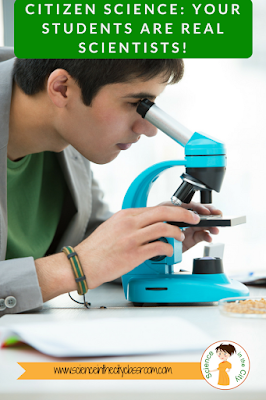Citizen Science: Real Scientists in the Classroom
Many times we try to do an activity with our students that we think is ‘fun’ or ‘engaging’ but we hear from our students things like “why do we need to know this?” or “this isn’t important.” Citizen science may be a missing piece to show our students that science is real, and they can be part of it.What is Citizen Science?
Citizen science projects are run by real scientists, but allow citizens, to help collect data, and be part of active scientific research. Here is a great infographic answering the question “What is Citizen Science?” from the Citizen Science Center.Here is a more thorough description, and even a great TED talk on the importance of Citizen Science. The TED talk would even be a good introduction to share with your students.
Why do citizen science with your students?
Being involved in a citizen science project can give your students a real sense of purpose, and can also expand upon what they are learning in class. These type of projects allow student to have experience ‘real science,’ and perhaps most importantly to to connect what they are learning to a real audience, so that it is more relevant. It allows them to get out of the classroom, and to put what they have learned in a larger context, or learn an extension. Here is a whole article on 8 Great Reasons Why You Should Use Citizen Science in Your Class.
How do I implement Citizen Science?
That’s really up to you. An entire elective course could be built around Citizen Science, a unit, an extension project, and extra credit project, or even a introductory.Where do I start?
Here is a printable list of resources and sites to search for Citizen Science Projects.


We also had quite a lengthy discussion in my Facebook group on this post. There are some really cool ideas being thrown around, and I’d love to have your input as well if you have done any of these. There is an almost endless array of different types of projects and topics, so find one that aligns well with your curriculum, your geography, or that interests your students and get out there and try it out!
Here are some links of places to look for projects (and I'm sure there are more).
Scientific American
The Litterati (data collection on litter)
Then report back! We’d love to hear how it goes!










No comments :
Post a Comment